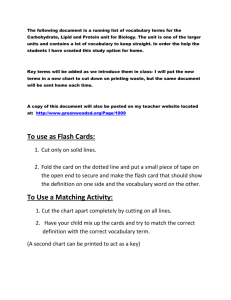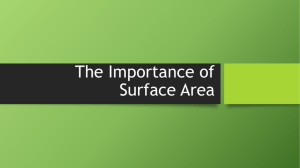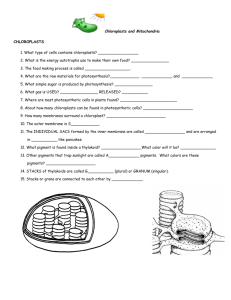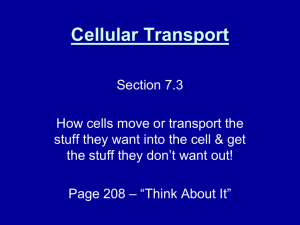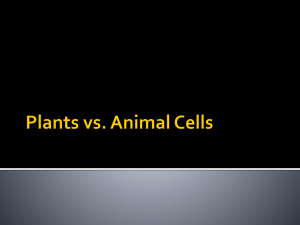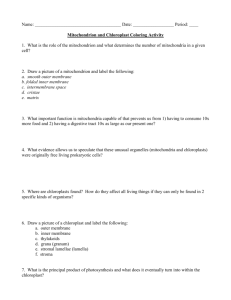How cells make and use energy
advertisement
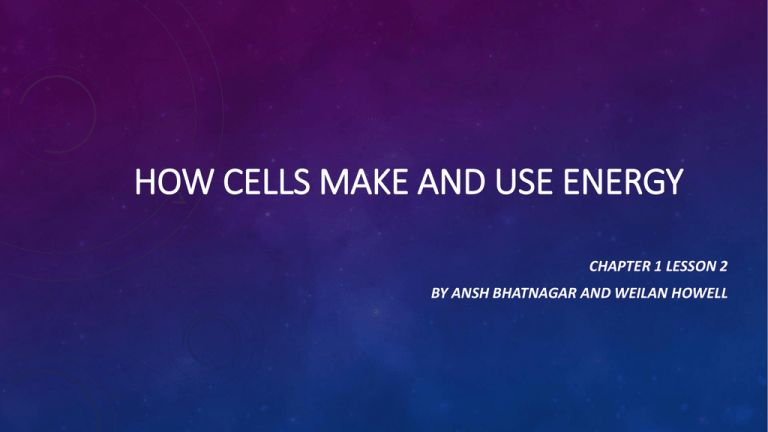
HOW CELLS MAKE AND USE ENERGY CHAPTER 1 LESSON 2 BY ANSH BHATNAGAR AND WEILAN HOWELL SUMMARY OF LESSON • From Houghton Mifflin “California Science” book HOW CELLS GET ENERGY ? Organisms eat food for energy, nutrients, and other materials that keep them alive. Cells in organisms help break down food into a molecule called glucose. Glucose is an example of sugar and is the building block for all sorts of other sugars. Plants make their own food from photosynthesis. Animals can not make their own food so they eat other animals or plants. Starches, which are found in potatoes and grains are huge chains of glucose molecules strung together. Cellulose is a type of starch found in wood and other tough plant parts. HOW CELLS MAKE ENERGY? • Cells make energy in a process called cellular respiration. Cellular respiration occurs in an organelle called the Mitochondrion. • Cellular respiration occurs in the Mitochondrion where glucose (C6,H12,O6) and oxygen (02) react to give out carbon-dioxide, water and energy. Energy is stored in a molecule called ATP. When the organism needs energy, it breaks down ATP. Plants and animals are able to store glucose very well. MITOCHONDRION PICTURE WHY CELLS NEED ENERGY? Cells need energy to stay alive. These are 4 important life functions of a cell. • Making Proteins- All cells make and use protein. Protein helps the cell control chemical reactions inside them. Protein also helps in structure and support of the cell. Hair, nails, skin, and bird feathers are made up of protein. • Movement- Muscle cells are able to contract and relax and the body moves accordingly. Muscle cells need more energy so they have more mitochondria. Single-celled organisms move in different ways. Sometimes the cell itself moves from one place to another, sometimes it uses oar-like structure and sometimes it uses a propeller like structure. CONTINUED…....... • Cell Division- New cells form when old cells divide into two. Babies start from single cell in their mother womb and the cell divides to become a trillion-celled organism. Cell division requires a lot of energy. • Transport of Materials- Cells are surrounded with a cell membrane which keeps materials in or out of the cell. The cell membrane keeps some things in and keeps some things out of the cell. The cell membrane also lets some things pass. It mostly requires a lot of energy for materials to pass through the cell membrane. MOVING MATERIALS • Cells need all sorts of materials including water, glucose, oxygen, and minerals such as potassium and sodium. Cells also produce waste products such as carbon dioxide that must be removed. In some cases, these materials move without the cell using any energy. This kind of movement is called PASSIVE TRANSPORT. • Diffusion is the simplest passive transport that spreads substances through a gas or a liquid. Materials diffuse from areas of high concentration to low concentration areas. OSMOSIS (A SPECIAL FORM OF DIFFUSION) • Osmosis takes place across a membrane that lets water pass but keeps out many things that are dissolved in the water. • In other cases, a cell needs to move materials opposite to the way diffusion would move them. This kind of movement is called active transport and it requires the cell to use energy. In active transport material move from low concentration to high concentration. Nerve cells move sodium and potassium in this way. ORGANISMS AND ENERGY • Individually, a cell does not need much energy, but there are so many cells in an organism, it needs a lot more energy. Not all organisms have the same energy needs. The need for energy is an important reason of why many large animals are endangered. The greater an animal’s need for food, the larger the area it must travel to find it. As humans take up more and more of Earth’s wild places, the largest animals often suffer the most. • A plant needs less energy than an animal because they do not move from place to place. A plant needs energy for growth and transporting materials. Sunlight provides enough energy for this task but not for rapid movement. In many cases the amount of energy determines how organisms grow and reproduce. VOCABULARY • Cellular Respiration- The process in which cells break down glucose in plants and animals. • Diffusion- A process that spreads substances through a gas or liquid. • Osmosis- A special form of diffusion that works to keep water inside the cell. •Beyond the Book! WHAT DO MITOCHONDRIA DO? • Mitochondria are commonly referred to as the energy source of cells. For example, brain cells need a lot of energy to be able to communicate with each other. Muscle fibers also need a lot of energy to help us to move, maintain our posture and lift objects and that’s why, we have lot of mitochondria in our muscles. • The energy made by the mitochondria is in the form of a chemical called adenosine triphosphate or ATP for short. ATP is an energy currency that every cell in our body can use and it keeps us alive. • Info: http://www.newcastle-mitochondria.com/mitochondria/what-do-mitochondria-do/ HOW DO CELLS KEEP ENERGY IN RESERVE? • When energy is abundant, cells make larger, energy-rich molecules to store their excess energy. The resulting sugars and fats are then held in reserviors within the cells, some of which are large enough to be visible in Electron micrographs. CONCLUSION • Cells need energy to accomplish the tasks of life. Beginning with energy sources obtained from their environment in the form of sunlight and organic food molecules, cells make energy-rich molecules like ATP. • Any excess energy is then stored in larger, energy-rich molecules called reservoirs. ANY QUESTIONS? • Thank you for your time!


